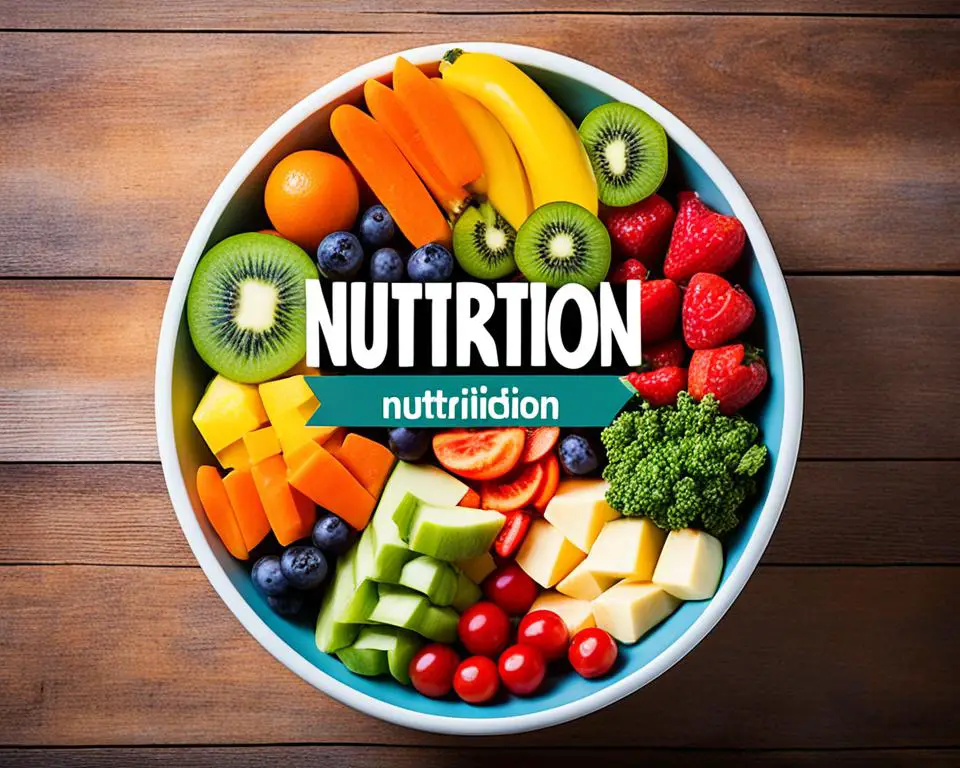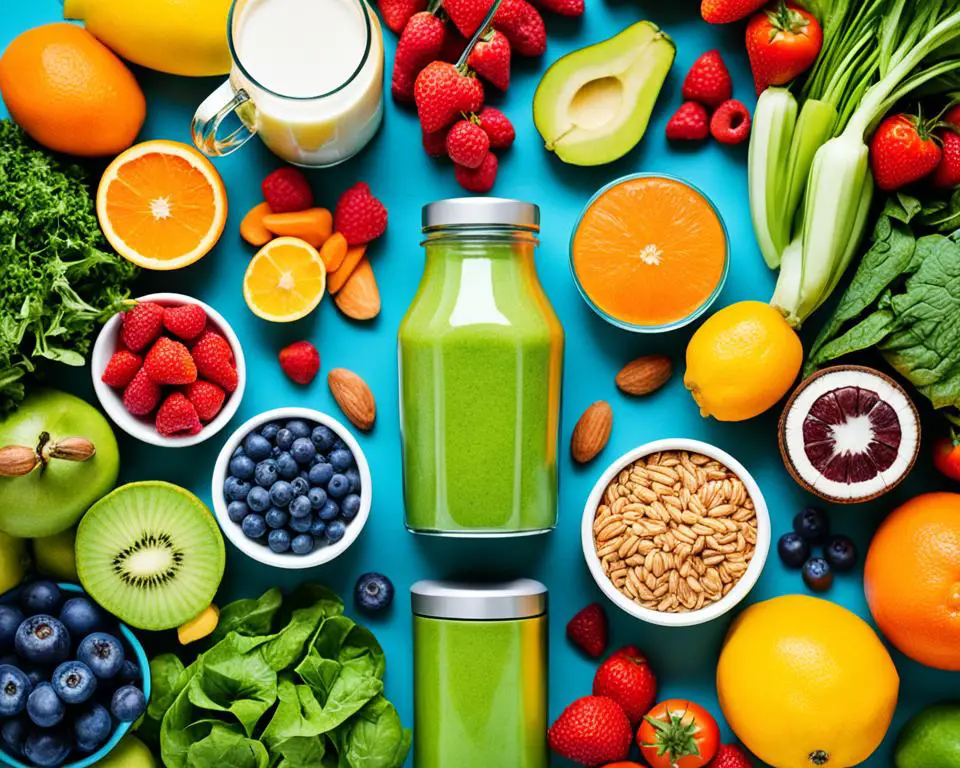Cow’s milk is a key source of important nutrients for our bodies. It’s packed with vitamins, minerals, proteins, fats, and carbohydrates. Knowing the calorie count in dairy milk is key for a balanced diet. A cup of whole cow’s milk with 3.25% fat has about 152 calories.
It also gives you around 8.14 grams of protein per cup. This protein is great for building muscles and staying healthy.
In the U.S., whole milk usually has about 3.25% fat, which is about 4% total fat. Polyunsaturated fats are around 2.3% of this total, and monounsaturated fats are about 28%. Lactose, a simple sugar, makes up about 5% of the carbs in milk.
Cow’s milk is also a great source of Vitamin B12, calcium, riboflavin, and phosphorus. Many types of milk are also fortified with Vitamin D. This boosts the health benefits of milk. But, some people may have trouble with lactose intolerance or milk allergies. So, it’s important to think about your own diet when adding dairy to your meals.
Key Takeaways
- A cup of whole cow’s milk with 3.25% fat provides 152 calories.
- Cow’s milk nutrition includes around 8.14 grams of protein per cup.
- Whole milk contains approximately 4% total fat.
- Lactose intolerance and milk allergies can affect milk consumption.
- Milk is rich in essential nutrients like Vitamin B12, calcium, and riboflavin.
Introduction to Dairy Milk Nutrition
Dairy milk comes from the mammary glands of mammals. It has been a key part of the human diet for thousands of years. This is because it’s packed with essential nutrients. Cow’s milk is a big part of our diet, giving us proteins, fats, carbs, and proteins.
Overview of Nutrients
One cup of whole milk has about 150 calories, 8 grams of fat, and 12 grams of sugars. It’s a great source of high-quality proteins like casein and whey. These proteins give us all the amino acids our bodies need.
Milk also has different levels of fat. Whole milk has about 3.25% fat. Reduced-fat milk has 2%, low-fat milk has 1%, and skim milk has 0%.
The Importance of Milk in the Diet
Adding dairy milk to our diet has many health benefits. A study in the American Journal of Clinical Nutrition found that kids who didn’t drink cow’s milk often didn’t get enough calcium or have strong bones. The Journal of Nutrition also said that dairy products help us get enough calcium and vitamin D.
Drinking milk can also lower the risk of high blood pressure, gum disease, and heart problems. This is what studies in the Current Cardiovascular Risk Reports and Nutrients found. These studies show how important milk is for our bones, metabolism, and heart health.
| Nutrient | Percentage of Daily Value |
|---|---|
| Calcium | 25% |
| Protein | 16% |
| Vitamin D | 15% |
| Phosphorus | 20% |
| Vitamin A | 15% |
| Riboflavin | 30% |
| Vitamin B12 | 50% |
The Caloric Content of Dairy Milk
Dairy milk comes in different types, each with its own calorie count. This variety helps people choose the best option for their diet. Knowing the calorie differences can help make healthier choices.
Whole Milk
Whole milk is loved for its creamy taste, thanks to its high fat content. A single cup of whole milk has about 146 whole milk calories. It’s a favorite for its rich flavor but remember to watch your calorie intake if you’re counting.
Reduced-Fat Milk
Reduced-fat milk, or 2% milk, is a good middle ground between taste and calories. It has around 122 calories per cup, less than whole milk. The reduced-fat milk benefits include less fat but still packs protein (8 grams per cup) and calcium (307mg per cup). It’s a smart pick for those wanting to eat less fat but still enjoy dairy’s creamy taste.
Low-Fat and Skim Milk
For a lighter choice, low-fat and skim milk are great options. Skim milk, or fat-free milk, has just 83 calories per cup. It’s perfect for those watching their calories. The skim milk nutrition includes 8 grams of protein per cup, giving you nutrients without extra fat.
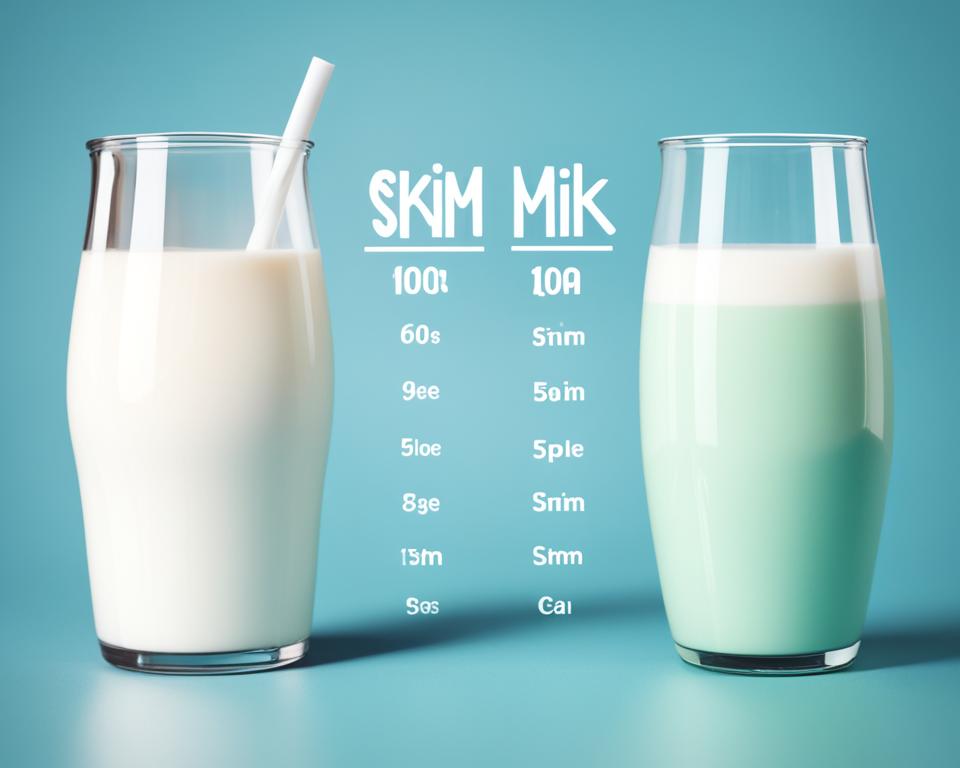
| Type of Milk | Calories per Cup | Protein (Grams) | Fat (Grams) |
|---|---|---|---|
| Whole Milk | 146 | 8 | 8 |
| Reduced-Fat Milk | 122 | 8 | 4.6 |
| Skim Milk | 83 | 8 | 0 |
Health Benefits of Dairy Milk
Dairy milk is packed with nutrients that are great for your health. It helps keep bones strong, supports muscle growth, and may lower the risk of heart disease.
Bone Health and Calcium
Dairy milk is a top source of calcium, which is key for strong bones and teeth. Eating foods high in calcium can lower the chance of osteoporosis, especially in older people. Kids from 1 to 3 years need about 350mg of calcium daily, which is found in 300ml of milk.
The Dietary Guidelines for Americans suggest having three 1-cup servings of non/low-fat milk or similar dairy foods. This helps increase calcium intake and supports bone health.
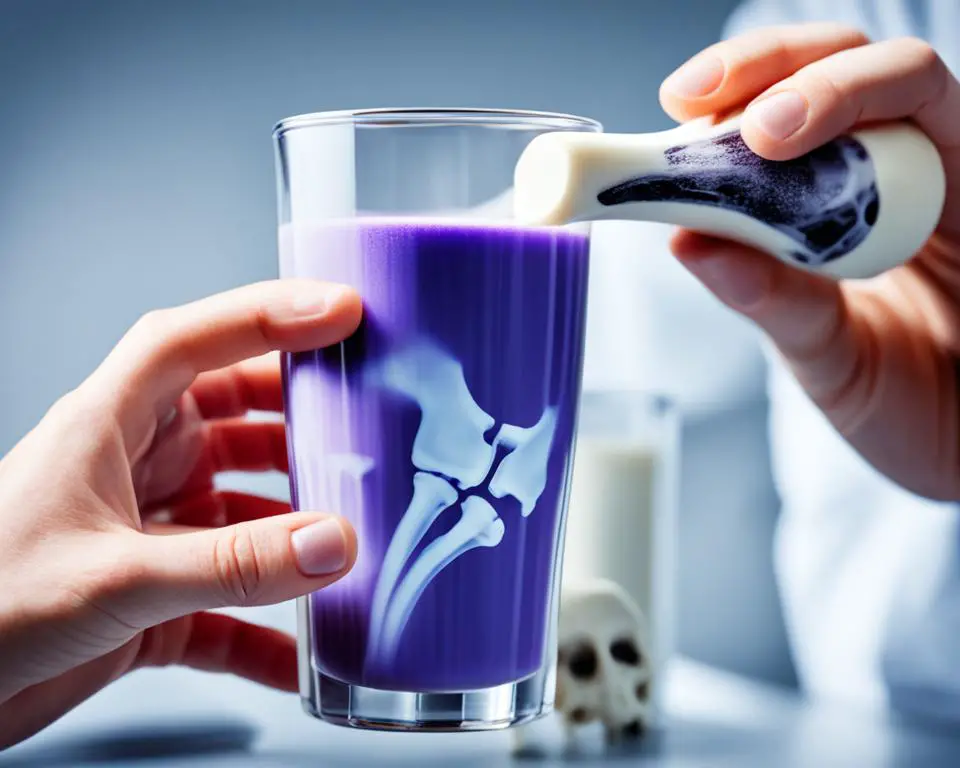
Protein and Muscle Development
Milk is full of protein, which is crucial for building and fixing muscles. The whey protein benefits in dairy milk are big for muscle growth. This makes dairy milk great for athletes and those wanting to gain muscle.
Whey protein is easy to digest and gets absorbed quickly. This makes it a top choice for protein.
Heart Health and Blood Pressure
New studies show that dairy milk can be good for the heart. Drinking low-fat and fat-free dairy can help control high blood pressure. This lowers the risk of heart diseases.
Dairy foods have nutrients like calcium, potassium, and magnesium. These are good for the heart.
| Dairy Product | Calcium (mg) | Fat (g) | Protein (g) |
|---|---|---|---|
| Whole Milk (1 cup) | 276 | 4.5 | 7.5 |
| Low-Fat Milk (1 cup) | 290 | 2.5 | 8 |
| Skim Milk (1 cup) | 300 | 0.3 | 8.5 |
Comparing Caloric Content in Different Types of Milk
It’s important to know the calorie differences in various milks for better diet choices. This section looks at the calories in cow’s milk and plant-based alternatives. It also covers powdered, evaporated, and condensed milk products.
Cow’s Milk vs. Plant-Based Milk
Cow’s milk and plant-based milks have different calorie counts. Let’s compare them:
| Type of Milk | Calories (per 8 oz) | Carbohydrates (g) | Sugars (g) | Fat (g) | Protein (g) |
|---|---|---|---|---|---|
| Cow’s Milk (Whole) | 150 | 12 | 12 | 8 | 8 |
| Cow’s Milk (1%) | 110 | 12 | 12 | 2 | 8 |
| Almond Milk (Unsweetened) | 40 | 1 | 0 | 3 | 2 |
| Soy Milk (Unsweetened) | 80 | 4 | 1 | 4 | 7 |
| Rice Milk (Unsweetened) | 120 | 22 | 10 | 2 | 0 |
| Coconut Milk Beverage (Unsweetened) | 50 | 2 | 0 | 5 | 0 |
Powdered, Evaporated, and Condensed Milk
Powdered, evaporated, and condensed milks have different nutritional profiles. Here’s a brief overview:
Powdered Milk: Powdered milk keeps many nutrients of fresh milk. It’s great for its long shelf life and ease of use, offering a good source of nutrients.
Evaporated Milk: Evaporated milk is made by removing about 60% of its water. It has a richer taste and is often used in recipes and baking.
Condensed Milk: Sweetened condensed milk has more sugar and a thick consistency. One cup of it has more calories than fresh milk, so it’s key to watch sugar intake.
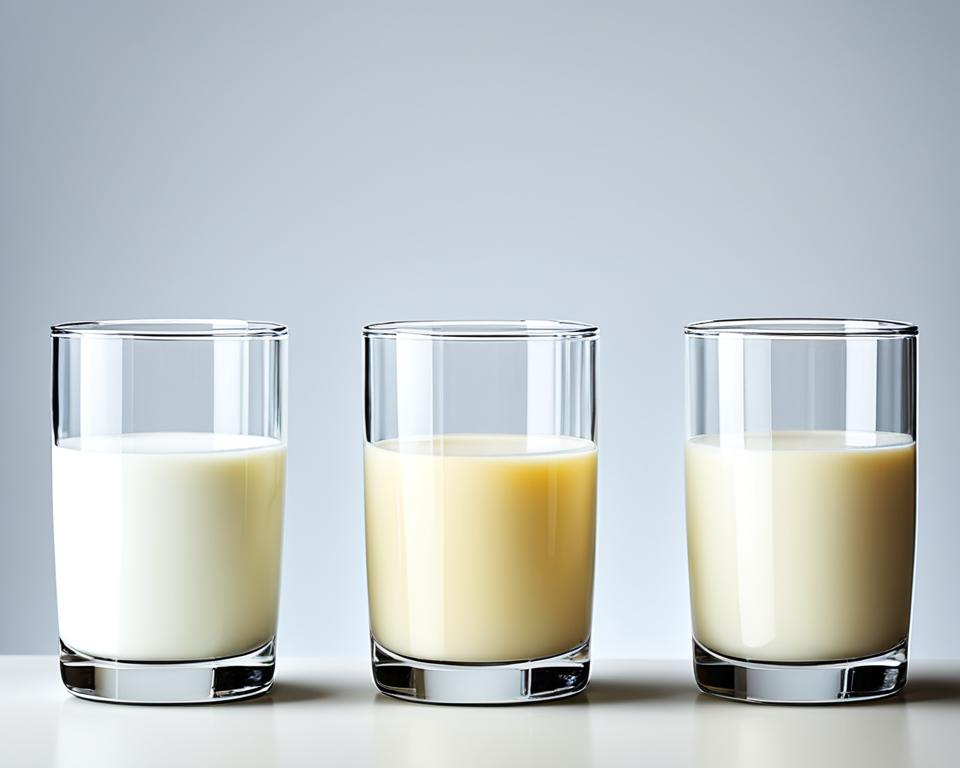
Understanding Milk Allergies and Intolerances
Milk allergies and intolerances are big health issues for many people. It’s key to know the difference between lactose intolerance and milk protein allergies for good dairy allergy management. Let’s look into these conditions to understand their effects and how to handle them.

Lactose Intolerance Explained
Lactose intolerance is a common food intolerance, affecting many adults worldwide. It happens when you don’t have enough lactase, the enzyme needed to break down lactose, a sugar in milk. Most people start showing signs of lactose intolerance in their early twenties.
But, surprisingly, most people with lactose intolerance can handle up to 12 grams of lactose at once, like in a glass of milk, without issues. Lactose intolerance symptoms include bloating, diarrhea, and gas. These happen because the lactose isn’t digested and ferments in the colon.
Tests like the Lactose Breath Test and the Lactose Tolerance Test can spot lactase deficiency. These tests help guide diet changes and help with dairy allergy management.
Milk Protein Allergies
Milk protein allergies happen when your body reacts to proteins in cow’s milk, like casein and whey. They’re not as common as lactose intolerance but hit about 1–2% of babies. These allergies can cause serious reactions, like hives, wheezing, and anaphylaxis.
Who gets milk protein allergies can depend on their race and other allergies. Boys with other allergies are more likely to get it. Tests like the Double-blind, Placebo-Controlled Oral Food Challenge and Specific Serum IgE tests help find these allergies, especially casein sensitivity.
Managing dairy allergy for milk protein allergies means avoiding cow’s milk and its products. You might use special formulas or plant-based milk instead. Most kids outgrow these allergies by age five, but some don’t.
Here’s a table that shows the main differences between lactose intolerance and milk protein allergies:
| Condition | Cause | Prevalence | Symptoms | Management |
|---|---|---|---|---|
| Lactose Intolerance | Lactase deficiency | 70-75% of adults | Gastrointestinal issues | Limit lactose intake |
| Milk Protein Allergies | Immune response | 1-2% of young children | Allergic reactions | Avoid dairy products |
The Role of Dairy Milk in Weight Management
Dairy milk is key to managing weight and boosting metabolic health. Studies show it helps control weight and improve body composition. This makes milk a great addition to diets for a healthy weight and metabolic health.
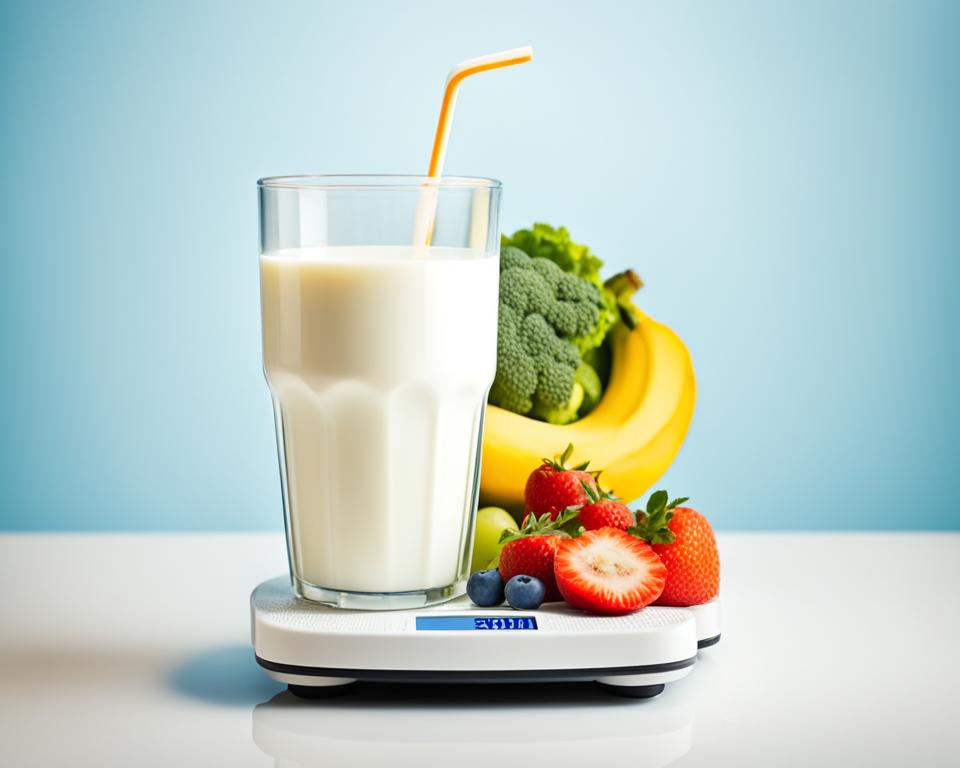
Milk and Metabolic Health
Adding dairy milk to your diet can boost metabolic health. Research shows a link between more milk and better metabolic health. In low-income Argentinean kids, drinking more milk led to better health.
A study in the US found no link between dairy and weight issues. In fact, dairy’s high calcium can help reduce body fat. Venezuelan teens with more calcium had lower BMI, showing milk’s health benefits.
Impact on Weight Loss and Gain
Dairy milk helps with losing and gaining weight the right way. Studies show more dairy means less fat and a lower obesity risk. For example, a 2016 review found yogurt linked to less weight, BMI, and body fat.
Kids drinking full-fat milk were 16% less likely to get overweight or obese than those on reduced-fat milk. This shows moderate dairy can help control weight well.
Drinking sweetened drinks often means less calcium and more weight gain in kids. Adding milk to their diets could cut down on these drinks and boost calcium, leading to healthier growth.
| Study | Findings |
|---|---|
| Argentinean School Children | Inverse association between insulin resistance and milk consumption |
| US Children and Adolescents | Positively associated with nutrient intake, no adverse weight status |
| Eales et al. (2016) | Yogurt consumption linked to lower body weight and BMI |
| Children consuming Full-fat Milk | 16% lower risk of overweight and 18% lower risk of obesity |
These studies show dairy milk’s many benefits for weight management. Adding dairy to your diet can improve metabolic health and help control weight.
Environmental Impact of Dairy Milk Production
The dairy industry has a big impact on the environment. It affects water, air, and releases greenhouse gases. These emissions harm the climate and threaten biodiversity.
In the EU, dairy milk makes up over a quarter of the carbon footprint. Sometimes, it’s as high as one-third. Compared to plant-based options, dairy milk produces more greenhouse gases, uses more land, and consumes more water.
Over the last 70 years, dairy farming has improved. It now uses less land, less feed, and less water to produce milk. This shows that efforts to reduce environmental impact are working.
But, dairy milk is higher in calories and protein than plant-based milks. Plant-based milks are often fortified with vitamins like D and B12.
| Factor | Dairy Milk | Plant-Based Milk |
|---|---|---|
| Greenhouse Gas Emissions | High | Low to Moderate |
| Land Use | 10 times higher | Lower |
| Water Use | 2 to 20 times more | Less |
In the UK, more adults are choosing non-dairy milks. Young people, especially, are turning to plant-based options. Yet, dairy milk is still the top choice, making up 96% of white milk sales.
Looking at the global dairy market, the U.S. has around 9 million cows. They produce over 223 billion pounds of milk each year. India produces more milk but uses less efficient methods.
The impact of dairy production on the environment is a big challenge. We need to adopt sustainable practices to reduce emissions and protect our planet.
Caloric Intake and Daily Dairy Consumption
It’s key to know how to add dairy to our daily meals for a balanced nutritional diet. The amount of dairy we should eat changes based on age, sex, and health goals. Following daily dairy guidelines helps get important nutrients without too many calories.
Recommended Daily Intake
The daily dairy guidelines say adults and kids needing 2,000 calories a day should eat about 3 cups of dairy. For example, 1 cup of low-fat milk on cereal, a ½ cup of calcium-fortified soymilk with a meal, 1 cup of low-fat plain yogurt, or one slice of low-fat cheddar cheese on a sandwich all count as dairy servings.
| Dairy Product | Calories (per 100 ml or g) |
|---|---|
| Almond Milk (Unsweetened) | 13 |
| Almond Milk (Original) | 22 |
| Goat Milk | 67 |
| Heavy Whipping Cream | 340 (per 100 g) |
| Human Milk | 304 (per 100 g) |
| Low-Fat Milk | 48 |
| Semi Skimmed Milk | 47 |
| Strawberry Milkshake | 165 (per 100 g) |
| Probiotic Yogurt | 65 (per 100 g) |
| Cheese Bread | 237 (per 100 g) |
| Mascarpone | 393 (per 100 g) |
| Whole Milk | 65 |
| Sweetened Condensed Milk | 321 |
Incorporating Dairy into a Balanced Diet
Adding dairy to a balanced diet means choosing wisely to meet dietary guidelines and health goals. Choosing low-fat or non-fat milk can help keep calories in check. Milk serving sizes should match daily guidelines to get enough nutrients like calcium, potassium, vitamin D, and protein without too many calories.
It’s important to vary dairy choices. Try using low-fat plain yogurt as a topping or sauce, pick fortified soymilk if cow’s milk isn’t an option, and add lower-fat cheeses like part-skim mozzarella to meals and snacks. Also, limit sugary dairy products to special times and teach kids why dairy is important daily.
Conclusion
Dairy milk is still the top choice in beverages, holding 90.5% of the market. Yet, its sales have dropped from $17.8 billion in 2015 to a forecasted 11% decline by 2020. On the other hand, nondairy beverages are on the rise, with a 9% increase in sales in 2015 and steady growth since then.
This shift is due to changing health views and food choices. Many see nondairy milk as a healthier choice for kids, with 46% of those who buy it drinking it every day. While dairy milk is rich in protein and minerals like calcium and vitamin D, nondairy options are also fortified to be just as nutritious.
It’s key to know the calories and nutrients in different milks to make smart food choices. The market has everything from whole to skim milk, and from cow’s to plant-based types. Adding dairy to a diet can boost health and wellness if you consider your nutritional needs and any allergies. In short, choosing between dairy and nondairy milk wisely can lead to a healthier lifestyle.
Source Links
- Milk 101
- Health Benefits of Milk
- Wait, So Is Milk Good for You or Not?
- Milk and Dairy Products and Their Nutritional Contribution to the Average Polish Diet
- Whole Milk Nutrition Facts
- Dairy Nutrition
- Your Comprehensive Nutrition Guide to All Types of Milk
- Milk Nutrition Facts and Health Benefits
- Cadbury Dairy Milk Chocolate Nutrition Facts | Livestrong.com
- Dairy and alternatives in your diet
- Dairy
- Milk
- Almond Milk vs. Cow’s Milk vs. Soy Milk vs. Rice Milk
- 1 chart shows the nutritional differences between types of milk, from oat to soy to cow’s
- Which Milk Should You Drink? Here’s a Calorie, Carb, and Protein Comparison to Help You Choose
- Milk Allergy vs. Lactose Intolerance: Definitions, Symptoms, Diagnosis
- Milk allergy-Milk allergy – Symptoms & causes – Mayo Clinic
- Understanding Types of Milk Allergies
- The Role of Dairy Products in Healthy Weight and Body Composition in Children and Adolescents
- Trying to lose weight? Why full-fat dairy may help you hit your goal
- Dairy and Healthy Weight in Adults | Dairy Nutrition
- Dairy vs. plant-based milk: what are the environmental impacts?
- How Dairy Milk Has Improved its Environmental and Climate Impact
- Examining the Environmental Impacts of the Dairy and Baby Food Industries: Are First-Food Systems a Crucial Missing Part of the Healthy and Sustainable Food Systems Agenda Now Underway?
- Milk & Dairy Products: Calories & Calorie Chart
- USDA MyPlate Dairy Group – One of the Five Food Groups
- Thomson
- Milk: Health benefits, nutrition, and risks
- Dairy and Plant-Based Milks: Implications for Nutrition and Planetary Health – Current Environmental Health Reports


